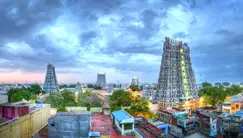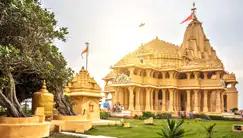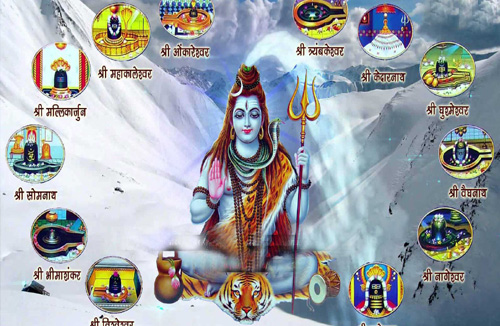The Bhimashankar Temple, located in the Sahyadri range of Maharashtra, India, is one of the 12 Jyotirlingas (shrines dedicated to Lord Shiva) and holds great historical and religious significance. This ancient temple has a rich history that spans several centuries, and it is revered by millions of devotees from all over the world. To delve into the history of the Bhimashankar Temple, we need to explore its origins, legends, architectural evolution, and its ongoing role as a sacred site.
Origins and Legends
The history of the Bhimashankar Temple is shrouded in myth and legend, making it a place of profound religious importance. There are several legends associated with its origin, and each adds a layer of mystique to the temple's history.
One popular legend is the story of Bhima, the Pandava prince from the epic Mahabharata. It is said that when the Pandavas were in exile, they came to the Sahyadri Mountains. Here, Bhima encountered a demon named Bhima, who terrorized the locals. In a fierce battle, Bhima defeated the demon and brought peace to the region. To commemorate this victory, a temple was built at the site, and it was named Bhimashankar.
Another legend is rooted in Hindu mythology and tells the tale of Lord Shiva and Goddess Parvati. It is said that Goddess Parvati once transformed herself into a beautiful woman and obstructed Lord Shiva's path while he was in deep meditation. This playful act led to an argument between the divine couple. In response, Lord Shiva assumed the form of Bhimashankar, creating a mountain with his huge thumb. He then appeared as a divine light, pacifying Goddess Parvati. This sacred spot, where Lord Shiva took the form of Bhimashankar, became the location of the temple.
Historical Evolution
The Bhimashankar Temple's historical evolution can be traced through various periods, each leaving its imprint on the temple's architecture and its role in the religious life of the region.
Ancient History: The temple's origin dates back to ancient times, and it is mentioned in several ancient texts, such as the Shiva Purana. Over the centuries, the temple complex evolved, and different dynasties and rulers played a role in its development. While specific records from this era may be scarce, the temple continued to grow in prominence.
Chalukyan Era: The Chalukya dynasty, which ruled parts of western and southern India between the 6th and 12th centuries, contributed to the temple's architecture. They left behind intricate carvings and inscriptions on the temple walls, showcasing their patronage.
Maratha Rule: The Marathas, a powerful and influential dynasty in western India during the 17th and 18th centuries, played a significant role in maintaining and renovating the temple. Under their patronage, the temple complex was expanded and embellished.
British Colonial Period: During British colonial rule, the temple, like many others in India, faced challenges. However, it continued to be a center of devotion for the local population, and the traditions were upheld by the local community.
Post-Independence Era: After India gained independence in 1947, the temple, along with many other religious sites, enjoyed a resurgence in popularity and received support for restoration and preservation.
Architectural Features
The Bhimashankar Temple is a magnificent example of Indian temple architecture, reflecting various influences from different historical periods. Its architecture showcases the rich artistic and cultural heritage of the region.
Nagara Style: The temple is primarily built in the Nagara architectural style, a style associated with North India. It features a prominent spire, known as a Shikhara, which rises above the sanctum sanctorum. The spire is adorned with intricate carvings and sculptures of various deities.
Carvings and Sculptures: The temple is adorned with beautifully crafted stone carvings and sculptures. These depictions include scenes from Hindu mythology, gods and goddesses, celestial beings, and various other intricate designs.
Mandap: The temple complex also includes a mandap or a hall for devotees to assemble. This hall is adorned with ornate pillars and intricately carved ceilings, adding to the temple's aesthetic appeal.
Courtyard: The temple is surrounded by a courtyard, and the entrance is marked by a magnificent gateway. The courtyard is often the site of various rituals and ceremonies.
Sacred Lingam: The main deity in the temple is a Shiva Lingam, representing Lord Shiva. The Lingam is the focal point of worship, and it is believed to be a self-manifested form of Lord Shiva, adding to the temple's significance.
Religious Significance
The Bhimashankar Temple holds immense religious significance, both as one of the 12 Jyotirlingas and as a place of pilgrimage for Shiva devotees. The Jyotirlingas are believed to be powerful representations of Lord Shiva, and each has its unique significance. Here are a few aspects of the temple's religious importance:
Jyotirlinga: As one of the 12 Jyotirlingas, the Bhimashankar Temple is considered to be a site where Lord Shiva is believed to have manifested himself as a divine light. This adds to its prestige and attracts pilgrims from far and wide.
Pilgrimage Site: Devotees from all over India and beyond visit Bhimashankar to seek the blessings of Lord Shiva. The temple complex sees a continuous flow of pilgrims throughout the year, with special significance during festivals dedicated to Lord Shiva.
Festivals: Maha Shivaratri, the great night of Shiva, is celebrated with immense enthusiasm at Bhimashankar. Devotees participate in night-long vigils, prayer services, and special rituals to honor Lord Shiva.
Religious Practices: The temple also plays a crucial role in fostering religious practices and rituals. Priests and religious scholars conduct pujas and yagnas, and the temple is a hub for religious education and discourse.
Conservation and Restoration
Preserving the historical and architectural heritage of the Bhimashankar Temple has been a priority for various authorities and organizations. Over the years, efforts have been made to conserve and restore the temple to ensure its longevity.
Government Initiatives: The Archaeological Survey of India (ASI) and state archaeological departments have played a role in the maintenance and restoration of the temple.
Local Communities: Local communities and religious trusts have also contributed to the upkeep of the temple. Their devotion and involvement have been instrumental in preserving the site.
Tourism and Pilgrimage: The temple's growing popularity as a tourist and pilgrimage destination has led to increased attention from both government and private stakeholders for its preservation.
Conclusion
The Bhimashankar Temple, with its deep-rooted history, architectural splendor, and religious significance, stands as a symbol of India's spiritual and cultural heritage. Its legends and traditions have been passed down through generations, and it continues to be a place of worship and devotion for millions of people. As it has evolved over the centuries, the temple remains a testament to the enduring legacy of Lord Shiva and the profound faith of those who visit it.








.jpg)
.jpg)



 Call
Call WhatsApp
WhatsApp Enquiry
Enquiry